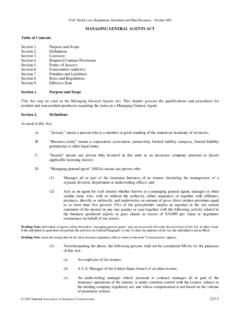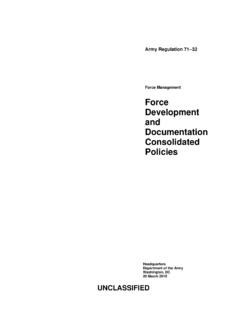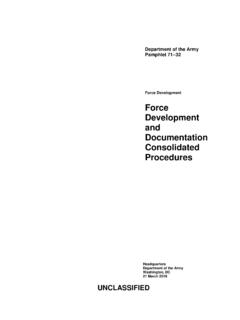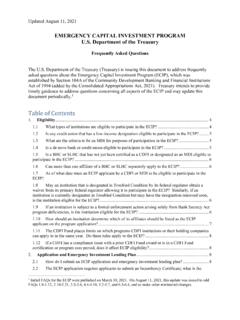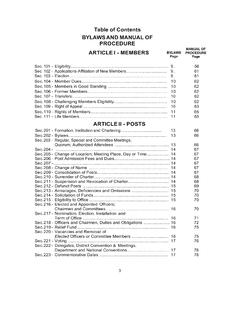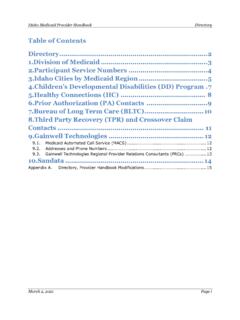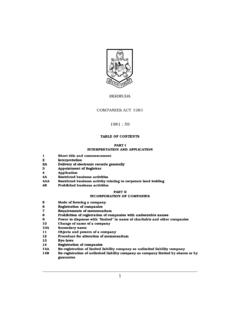Transcription of Table of Contents - ArcelorMittal
1 Table of ContentsPageManagement reportIntroductionCompany overview3 History and development of the Company3 Cautionary Statement Regarding Forward-looking statements 9 Key transactions and events in 202010 Risk Factors14 Business overviewBusiness strategy35 Research and development36 Sustainable development40 Products54 Sales and marketing58 Insurance59 Intellectual property59 Government regulations60 Organizational structure65 Properties and capital expendituresProperty, plant and equipment68 Capital expenditures90 Reserves and Resources (iron ore and coal)92 Operating and financial reviewEconomic conditions98 Operating results119 Liquidity and capital resources131 Disclosures about market risk136 Contractual obligations138 Outlook139 Management and employeesDirectors and senior management140 Compensation147 Corporate governance163 Employees172 Shareholders and marketsMajor shareholders177 Related party transactions179 Markets180 New York Registry Shares180 Purchases of equity securities by the issuer and affiliated purchasers181 PageShare capital182 Additional informationMemorandum and Articles of Association182 Material contracts191 Exchange controls and other limitations affecting security holders193 Taxation194 Evaluation of disclosure controls and procedures198 Management s report on internal control over financial reporting 198 Glossary - definitions.
2 Terminology and principal subsidiaries200 Chief executive officer and chief financial officer s responsibility statement202 consolidated financial statements for the year ended December 31, 2020203 consolidated statements of operations204 consolidated statements of other comprehensive income205 consolidated statements of financial position206 consolidated statements of changes in equity207 consolidated statements of cash flows208 Notes to the consolidated financial statements209 Report of the r viseur d entreprises agr - consolidated financial statements321 Annual report of ArcelorMittal parent company for the year ended December 31, 2020326 Management report327 Chief executive officer and chief financial officer s responsibility statement 328 Financial statements of ArcelorMittal parent company for the year ended December 31, 2020329 Statements of financial position330 Statements of operations and statements of other comprehensive income331 Statements of changes in equity332 Statements of cash flows 333 Notes to the financial statements334 Report of the r viseur d entreprises agr financial statements379 IntroductionCompany overviewArcelorMittal is one of the world s leading integrated steel and mining companies.
3 ArcelorMittal is the largest steel producer in the Americas and Europe, second largest in Africa and the sixth largest steel producer in the CIS region and has a smaller but growing presence in Asia. steelproduction(million tonnes)Iron ore production(million tonnes)Coal production(million tonnes)Steel shipments(million tonnes)Sales(billion USD)The Company's key metrics above include the operations prior to its sale (see " Key transactions and events in 2020"): operations (in million tonnes) Crude steelIron has steel-making operations in 17 countries on four continents, including 38 integrated and mini-mill steel-making facilities following the sale of ArcelorMittal USA. As of December 31, 2020, ArcelorMittal had approximately 168,000 produces a broad range of high-quality finished and semi-finished steel products ("semis"). Specifically, ArcelorMittal produces flat products, including sheet and plate, and long products, including bars, rods and structural shapes.
4 It also produces pipes and tubes for various applications. ArcelorMittal sells its products primarily in local markets and to a diverse range of customers in approximately 160 countries, including the automotive, appliance, engineering, construction and machinery industries. ArcelorMittal s mining operations produce various types of mining products including iron ore lump, fines, concentrate and sinter feed, as well as coking, PCI and thermal coal for consumption at its steel-making facilities some of which are also for sale commercially outside of the a global steel producer, the Company is able to meet the needs of different markets. Steel consumption and product requirements clearly differ between developed markets and developing markets. Steel consumption in developed economies is weighted towards flat products and a higher value-added mix, while developing markets utilize a higher proportion of long products and commodity grades. To meet these diverse needs, the Company maintains a high degree of product diversification and seeks opportunities to increase the proportion of higher value-added products in its product mix.
5 History and development of the Company ArcelorMittal results from the merger in 2007 of its predecessor companies Mittal Steel Company and Arcelor, each of which had grown through acquisitions over many years. Since its creation ArcelorMittal has experienced periods of external growth as well consolidation and deleveraging (including through divestment). ArcelorMittal 's success is built on its core values of sustainability, quality and leadership and the entrepreneurial boldness that has empowered its emergence as the first truly global steel and mining company. Acknowledging that a combination of structural issues and macroeconomic conditions will continue to challenge returns in its sector, the Company has adapted its footprint to the new demand realities, redoubled its efforts to control costs and repositioned its operations with a view toward outperforming its competitors. ArcelorMittal s research and development capability is strong and includes several major research centers as well as strong academic partnerships with universities and other scientific bodies.
6 Against this backdrop, ArcelorMittal 's strategy is to leverage four distinctive attributes that will enable it to capture leading positions in the most attractive areas of the steel industry s value chain, from mining at one end to distribution and first-stage processing at the other: global scale and scope; superior technical capabilities; a diverse portfolio of steel and related businesses, one of which is mining; and financial capabilities. The Company s strategy is further detailed under Business overview Business strategy . ArcelorMittal s steel-making operations have a high degree of geographic diversification. Approximately 38% of its crude steel was produced in the Americas, approximately 47% was produced in Europe and approximately 15% was produced in other countries, such as Kazakhstan, South Africa and Ukraine 3 Management reportin 2020. In addition, ArcelorMittal s sales of steel products are spread over both developed and developing markets, which have different consumption characteristics.
7 ArcelorMittal s mining operations, present in South America, Africa, Europe and the CIS region, are integrated with its global steel-making facilities and are important producers of iron ore and coal in their own right. Competitive strengthsAs shown by the following graph, ArcelorMittal has a diversified portfolio of steel and mining products to meet a wide range of customer needs across many steel-consuming sectors, including automotive, appliance, engineering, construction, energy and machinery and via distributors. Group sales by market (2020)27%19%16%10%3%14%11%DistributionCo nstructionAutomotivePrimary TransformationPackagingOther Steel sales*Other sales** Other steel sales mainly represent metal processing, machinery, electrical equipment and domestic appliances**Other sales mainly represent mining, chemicals & water, slag, waste, sale of energy and shippingThe Company believes that the following factors contribute to ArcelorMittal s success in the global steel and mining industry:Market leader in steel.
8 ArcelorMittal had annual achievable production capacity of approximately 108 million tonnes of crude steel (92 million tonnes of crude steel after the sale of ArcelorMittal USA as described in Key transactions and events in 2020) for the year ended December 31, 2020. Steel shipments for the year ended December 31, 2020 totaled million tonnes. ArcelorMittal has significant operations in many countries which are described in "Properties and capital expenditures". In addition, many of ArcelorMittal s operating units have access to developing markets that are expected to experience, over time, above-average growth in steel consumption (such as Central and Eastern Europe, South America, India, Africa, CIS and Southeast Asia).The Company sells its products in local markets and through a centralized marketing organization to customers in approximately 160 countries. ArcelorMittal s diversified product offering, together with its distribution network and research and development ( R&D ) programs, enable it to build strong relationships with customers, which include many of the world s major automobile and appliance manufacturers.
9 The Company is a strategic partner to several of the major original equipment manufacturers ( OEMs ) and has the capability to build long-term contractual relationships with them based on early vendor involvement, contributions to global OEM platforms and common value-creation world-class mining business. ArcelorMittal has a global portfolio of 10 operating units with mines in operation and development and is among the largest iron ore producers in the world. In 2020, ArcelorMittal sourced a large portion of its raw materials from its own mines and facilities including finance leases. The Table below reflects ArcelorMittal 's self-sufficiency through its mining operations in 2020. Millions of metric tonnes ConsumptionSourced from own mines/facilities2 Other sourcesSelf-sufficiency %Iron & & Includes coal only for the steelmaking process and excludes a small proportion of weak metallurgical coals for boiler power generation. ArcelorMittal 's consumption of PCI and coal was million tonnes and million tonnes, respectively, for the year ended December 31, Assumes 100% consumption of ArcelorMittal 's iron ore and coal Company has iron ore mining activities in Brazil, Bosnia, Canada, Kazakhstan, Liberia, Mexico, Ukraine, the United States (until the divestment of ArcelorMittal USA see " Key transactions and events in 2020") and through its joint venture in India.
10 It has coal mining activities in Kazakhstan and the United States (until the divestment of ArcelorMittal Princeton see " Key transactions and events in 2020"). ArcelorMittal s main mining products include iron ore lump, fines, concentrate, pellets, sinter feed, metallurgical coals including hard, weak and PCI suitable coals. In addition, ArcelorMittal produces substantial amounts of direct reduced iron, or DRI, which is a Management report 4scrap substitute used in its mini-mill facilities to supplement external metallic purchases. As of December 31, 2020, ArcelorMittal s iron ore reserves (including 100% of reserves at mines where ArcelorMittal owns less than 100%, and reserves for which use is restricted) were estimated at 4,089 million tonnes run of mine and its total coking coal reserves were estimated at 101 million tonnes run of mine or 58 million wet recoverable tonnes. See Property and capital expenditures Reserves (iron ore and coal) for a detailed list of the entities with reserves and ownership structure.



